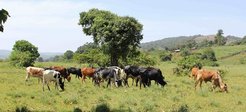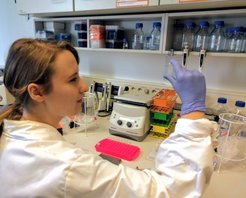6,000 years of dairying in Africa
New research shows dairy consumption in eastern Africa began before the evolution of lactase persistence
Got milk? The 1990s ad campaign in the US highlighted the importance of milk for health and wellbeing, but when did we start consuming the milk of other animals? And how did the practice spread? A new study led by scientists from Germany and Kenya highlights the critical role of Africa in the story of dairying, showing that communities there were using milk by 6,000 years ago.

Cattle grazing in Entesekara in Kenya near the Tanzanian border
An international team led by researchers at the Max Planck Institute for the Science of Human History in Jena, Germany and the National Museums of Kenya (NMK) in Nairobi, Kenya, analyzed human remains from 41 adult individuals from 13 ancient pastoralist sites excavated in Sudan and Kenya and, remarkably, retrieved milk proteins from eight of the individuals. Researchers can detect milk proteins in dental calculus, where they are preserved for thousands of years. However, in Africa high temperatures and humidity were thought to interfere with protein preservation.

Lead author Madeleine Bleasdale preparing bone samples for the study.
The positive results were greeted with enthusiasm by the team. As lead author Madeleine Bleasdale observes, “some of the proteins were so well preserved, it was possible to determine what species of animal the milk had come from. And some of the dairy proteins were many thousands of years old, pointing to a long history of milk drinking in the continent.” The earliest milk proteins reported in the study were identified at Kadruka 21, a cemetery site in Sudan dating to roughly 6,000 years ago. In the calculus of another individual from the adjacent cemetery of Kadruka 1, dated to roughly 4,000 years ago, researchers were able to identify species-specific proteins and found that the source of the dairy had been goat’s milk.
"This the earliest direct evidence to date for the consumption of goat’s milk in Africa,” says Bleasdale. “It’s likely goats and sheep were important sources of milk for early herding communities in more arid environments.”
The team also discovered milk proteins in dental calculus from an individual from Lukenya Hill, an early herder site in southern Kenya dated to between 3,600 and 3,200 years ago. “It seems that animal milk consumption was potentially a key part of what enabled the success and long-term resilience of African pastoralists,” observes coauthor Steven Goldstein.
Genetic mutations for milk digestion
Milk is an extraordinary food and therefore of special interest for research on human development. Normally, lactase – an enzyme critical for enabling the body to fully digest milk – disappears after childhood, making it much more difficult for adults to drink milk without discomfort. But in some people, lactase production persists into adulthood – in other words these individuals have ‘lactase persistence.’ In Europeans, there is one main mutation linked to lactase persistence, but in different populations across Africa, there are as many as four.
However, the early milk drinkers examined in the current study did not carry such a mutation. People were consuming dairy products without the genetic adaptation that supports milk drinking into adulthood. But how could they drink milk without the enzyme needed to digest it? The answer may lie in fermentation. Dairy products like yogurt have a lower lactose content than fresh milk, and so early herders may have processed milk into dairy products that were easier to digest.
Genes and culture evolving together
Dairying and human biology co-evolved has remained largely mysterious despite decades of research. Drinking milk may have actually created the conditions that favored the emergence and spread of lactase persistence in African populations. As senior author and Max Planck Director Nicole Boivin notes, “This is a wonderful example of how human culture has – over thousands of years – reshaped human biology.”
As research on ancient dairying intensifies around the world, Africa remains an exciting place to examine the origins of milk drinking. The unique evolution of lactase persistence in Africa, combined with the fact that animal milk consumption remains critical to many communities across the continent, makes it vital for understanding how genes and culture can evolve together.
Critical to the success of the recent study was the Max Planck scientists’ close partnership with African colleagues, including those at the National Corporation of Antiquities and Museums (NCAM), Sudan, and long-term collaborators at the National Museums of Kenya (NMK). “It’s great to get a glimpse of Africa’s important place in the history of dairying,” observes coauthor Emmanuel Ndiema of the NMK. “













